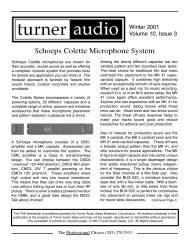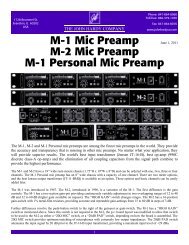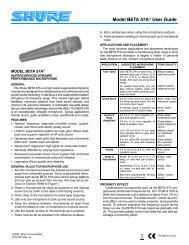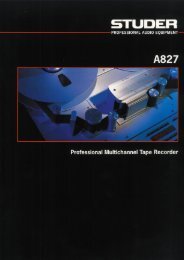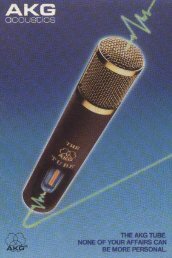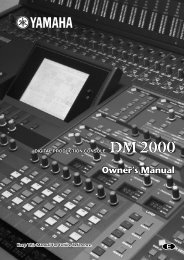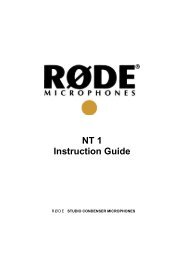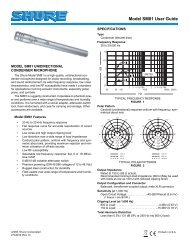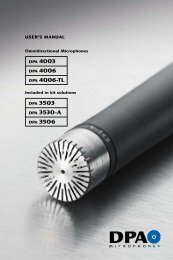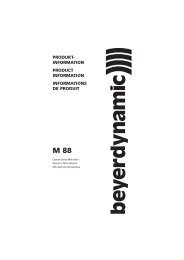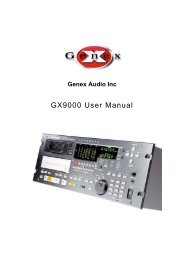Lexicon 480L | PDF - Freeverb3
Lexicon 480L | PDF - Freeverb3
Lexicon 480L | PDF - Freeverb3
You also want an ePaper? Increase the reach of your titles
YUMPU automatically turns print PDFs into web optimized ePapers that Google loves.
<strong>Lexicon</strong> <strong>480L</strong> Owner's Manual<br />
Page One<br />
DST<br />
Distortion Mix<br />
EXM<br />
Expansion Mix<br />
XOV<br />
Xover Frequency<br />
HFC<br />
High Freq Cut<br />
XOM<br />
Xover Mix<br />
DGN<br />
Distortion Gain<br />
Page Two<br />
TSL<br />
Treble Slope<br />
TBR<br />
Treble Rotate<br />
TBM<br />
Treble Max Gain<br />
EXP<br />
Expansion Slope<br />
SUS<br />
Sustain<br />
DHP<br />
Distortion Hi Pass<br />
Page Three<br />
DLY<br />
Front Delay<br />
LSL<br />
Lo Freq Comp Ratio<br />
LFR<br />
Lo Freq Rotation Pt<br />
LMG<br />
Lo Freq Max Gain<br />
ATC<br />
Attack Time Const<br />
RTC<br />
Release Time Const<br />
Page Four<br />
GATE<br />
Noise Gate<br />
The Distression Program<br />
The Frequency Distression algorithm is extremely versatile<br />
at creating frequency compressed or distorted<br />
effects.<br />
Distression is a Mono in (left channel), Dual Mono<br />
output program. The right channel input is ignored and<br />
not processed. These programs can be run in any <strong>480L</strong><br />
configuration.<br />
ALL PRESETS SHOULD BE UTILIZED<br />
“PRE-FADER” FROM THE CONSOLE SOURCE.<br />
This program can be thought of as a low pass/high pass<br />
crossover feeding independent compressor modules.<br />
The high pass compressor feeds a dedicated distortion<br />
module capable of driving various parametric controls.<br />
The Frequency Distression programs represent a wide<br />
variety of different frequency-compressed and distorted<br />
effects from the very subtle to the awesome<br />
sublime. Many presets are simply labeled with an<br />
instrument name. This suggests the type of instrument<br />
which should be fed into the effect input.<br />
About the Parameters<br />
Page 1<br />
DST (Distortion Mix - sine/cosine)<br />
DST controls the amount of signal following treble<br />
compression either passing through the distortion<br />
module or bypassing around it.<br />
EXM (Expansion Mix - linear)<br />
EXM controls the amount of signal following treble<br />
compression either passing through all of the distortion<br />
parameters (including the distortion expansion) or bypassing<br />
it. A LARC value of 0 means absolutley no<br />
amount of distorted signal is being passed to XOM.<br />
XOV (Crossover Frequency)<br />
XOV is a6dB/octave low frequency, 12dB/octave high<br />
frequency sliding filter which determines what frequencies<br />
are low frequency and high frequency.<br />
HFC (High Frequency Cut)<br />
HFC controls the roll-off characteristics of the distorted<br />
content of the signal.<br />
XOM (Crossover Mix - sine/cosine)<br />
XOM controls the mix of low frequency and high<br />
frequency signals. It is the final mix control in the<br />
program.<br />
DGN (Distortion Gain)<br />
DGN controls the amount of distortion gain up to 6dB.<br />
13-4


